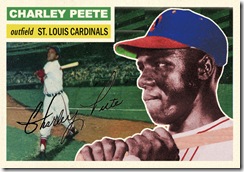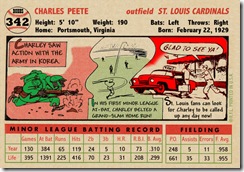 From Pickles Dillhoefer and Austin McHenry in 1922 to Josh Hancock in 2007, the St. Louis Cardinals have, perhaps as much as any Major League Baseball team, suffered the untimely death of its players.
From Pickles Dillhoefer and Austin McHenry in 1922 to Josh Hancock in 2007, the St. Louis Cardinals have, perhaps as much as any Major League Baseball team, suffered the untimely death of its players. Probably none was more tragic and poignant than that of Charley Peete in late 1956, who died, along with his wife and three children, in a commercial airliner crash in South America.
Peete never appeared on a true baseball card in his short professional career, and on only a couple of collectibles as a minor leaguer. I recently made him the subject of one of my custom card creations, in the format of 1956 T
 opps. Besides showing you how the card turned out, I thought it appropriate to share Peete’s story with you.
opps. Besides showing you how the card turned out, I thought it appropriate to share Peete’s story with you. Various contemporary sources give differing spellings of Peete’s name. An obituary in the local paper said that while an extra “e” was usually attached to his surname in the sports pages, the family said “Peet” was correct. Some sources give his informal name as Charlie, though he spelled it Charley when signing autographs, and used the Peete spelling on all known autographs, occasionally adding a “Jr.,” as his father’s name was also Charles. He was not known to have a middle name.
Peete claimed he was not a sports standout at Norcum High School in Portsmouth, Va., but he played baseball and football and ran track. He ran the 100-yard dash in 10 seconds and demonstrated an outstanding throwing arm.
Following high school, he played for various teams in Portsmouth’s competitive black semi-pro circuit. In 1950, at age 21, Charley played briefly with the Indianapolis Clowns of the Negro American League, then with his teenage brother Jimmy traveled from southeastern Virginia to participate in the inaugural season of the Manitoba-Dakota League, a professional circuit outside of Organized Baseball. Charley played for the Brandon Greys, whose 32-16 record was tops in the circuit, but who lost the league championship to the Winnipeg Buffaloes in the playoffs.
The ManDak League was notable for the number of Negro Leagues veterans who populated its rosters. Aging stars such as Leon Day, Ray Dandridge, Lyman Bostock Sr., and Willie Wells, Sr. and Jr. played there. The Minot Mallards even persuaded Satchel Paige to sign a three-game contract (at three innings per game), from whom leftie Jimmy Peete learned a thing or two about pitching as a teammate. Jimmy played in the minor leagues from 1955-59, reaching as high as the Pacific Coast League.
The Army reached out to Charley Peete after his season in Canada and he served in the Korean War. When he returned to civilian life in 1953, Charley petitioned Frank Lawrence, who owned the Portsmouth Merrimacs of the Class B Piedmont League, for a tryout. Peete had bulked up on army chow and at 190-200 pounds, had packed on such muscle that his teammates called him “Mule,” as in, “strong as a . . . .”
That strength was manifested in an outstanding throwing arm. One teammate said Peete could “hang blurred ropes” from right field, and that his throws “made a boiling, churning sound” as they went through the air.
Peete’s timing was good for his entry into Organized Baseball. In 1953 the Piedmont League, comprising teams in Pennsylvania, Maryland and Virginia, was in its first year of integration, with seven black players on four of its team as the season opened. Peete was given a uniform and began working out with the ’Macs. A few days later, he was called on to pinch-hit and in his first at-bat he hit a 3-2 pitch for a grand slam home run. He won the right field job and hit .275 for the season. For a brief 10-game period, one of Peete’s teammates on the ’Macs was Negro Leagues star and future Hall of Famer Buck Leonard, who was playing his only games in integrated Organized Baseball.
Peete followed up in 1954 by boosting his BA to .311 and his homerun output from four to 17. The Rochester Redwings, to the consternation of owner Merrimac’s owner Lawrence, an independent operator who had tried to sell Peete to St. Louis earlier that year, drafted Peete for what Lawrence termed a bargain price.
Peete made the jump from the Class B Piedmont League to the AAA International League for 1955. He was batting .280 for the Redwings after the first month of the minor league season, and the other St. Louis AAA farm club, the Omaha Cardinals of the American Association, purchased his contract to fill a vacancy in center field. The 1955 season was Omaha’s first at the Triple-A classification, the Cardinals having moved the team there from Columbus.
Charley ended the 1955 season at Omaha with a .317 BA, nine home runs and 63 RBI in 99 games. His combined batting record for Rochester and Omaha in 1955 was .310-10-73.
Peete appears in a very collectible team photo of the 1955 Omaha Cardinals. The Cardinals farm system in the early 1950s was, virtually across the board, prolific in its issue of team pictures and other collectibles. The ’55 Omaha picture is especially nice in that it is printed in rich, full color. The blank-backed, thin cardboard picture measures 6-3/4” x 4-3/4” and was, according to Dan Bretta, who supplied the scan illustrated herewith, a stadium giveaway.
Peete played winter ball in 1955 with Almendares in the Cuban League and Pastora in Venezuela’s Occidental League.
The 1956 season opened with Peete back in Omaha and hitting well enough that the Cardinals called him up on July 16. He arrived in St. Louis hampered by a split thumb and was able to hit only .192 with little power in 23 games over the month and a day that, as it developed, would comprise his entire major league career. Peete’s unorthodox batting style, which included dipping his bat as he swung, allowed big league pitchers to exploit his weakness on the low inside curve and he struck out in 10 of his 52 at-bats.
He was returned to Omaha and when he resumed his hot hitting and ended the season leading the Association with a .350 average, he was once again being touted as one of the Cardinals brightest prospects.
At Omaha in ’56 he was one of 22 O-Cards who appeared in a team-issue “PICTURE-PAK” that is actually a plastic comb-bound booklet of 3-1/2” x 4-3/8” facsimile autographed black-and-white photos. With the 1955 team photo, the picture pack is about the only remotely accessible Charley Peete memorabilia available to today’s collectors. A handful of Charley Peete autographs are known, but they are not inexpensive. One example on a 3x5 index card has been offered on an internet sales site for $1,600.
We’ll never know whether Charley Peete would have achieved major league stardom or his collectibles become ubiquitous because he didn’t live to see his 28th birthday. On Nov. 26 he boarded Linea Aeropostal Venezolana’s Flight 253 at Idlewild Airport in New York with his wife Nettie, age 21, their three young children (Deborah, 26 months, Karen, 15 months, and Kenny, not yet a month old), 13 other passengers and a crew of seven for an overnight flight to Caracas, where he was to join the Valencia team in the Venezuelan Association. Charley had begun the 1956-57 winter ball season with Cienfuegos in the Cuban League, but left after a few weeks.
Just after 8 a.m. on Nov. 27, the pilot of the Lockheed Constellation radioed that he was approaching Maiquetia, Caracas’ seaside airport in a rainstorm. He was two miles away. The plane never arrived; its charred wreckage was discovered later that day in cloud-shrouded 6,700-foot mountains nearby. There were no survivors. It was reported the bodies of the crash victims were buried the next day in Caracas. It is not known whether the Peete family’s remains were ever returned to their Portsmouth home.
A Little League field in Portsmouth is named for Charley Peete.
UPDATE: On Aug. 22, 1957, what The Sporting News described as an "elaborate bronze plaque" was permanently mounted on the wall of the stadium concourse. Peete's brother Jim, a pitcher for Reading (Eastern League) in the Cleveland organization, and Charley Peete's mother-in-law, Mrs. Odessa Davis, of Portsmouth, Va., attended the unveiling.
Since old Rosenblatt Stadium was demolished in 2010, I wonder where the plaque is today?

No comments:
Post a Comment
Your comments, criticism, additional information, questions, etc., are welcome . . . as long as they are germane to the original topic. All comments are moderated before they are allowed to appear and spam comments are deleted before they ever appear. No "Anonymous User" comments are allowed.